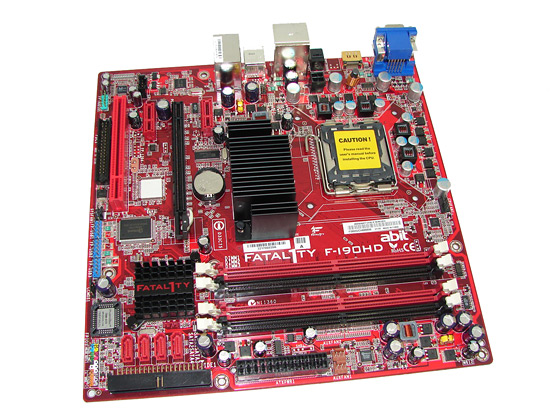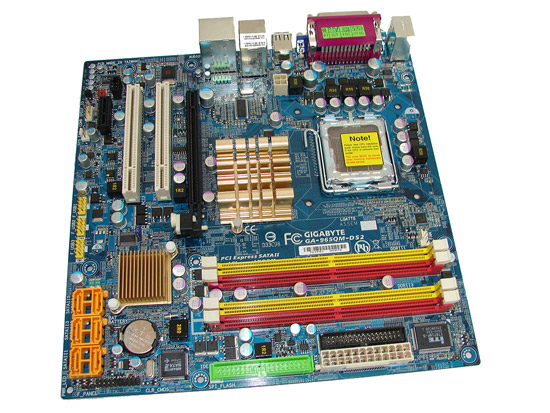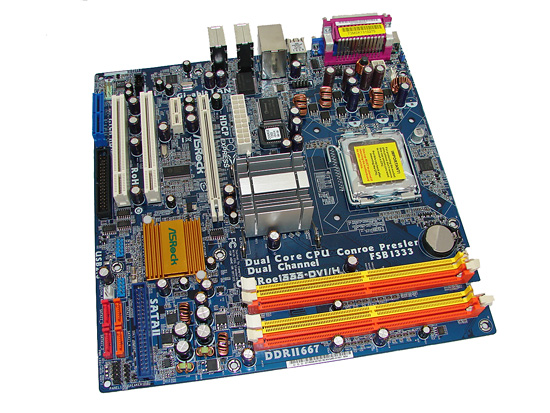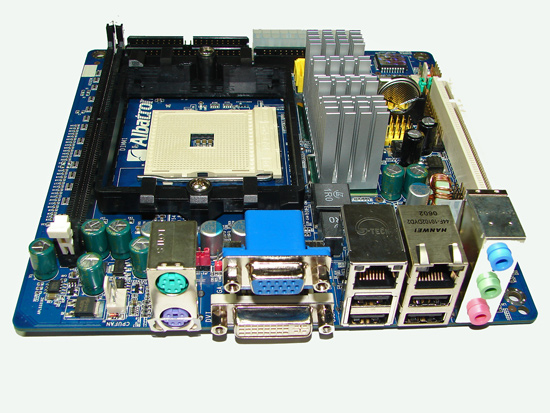Motherboard Products: Intel uATX
The Intel uATX motherboard suppliers have been slow to ramp up production of boards supporting the Core 2 Duo processor but we have several in for testing now based on the Intel G965/Q965 chipsets along with new performance enhancing graphics drivers. We are also expecting a few 946GZ based boards shortly that make a perfect match for the Intel E4xx series of Core 2 Duo processors with an 800MHz front side bus.

The abit Fatal1ty F-I90HD motherboard is based on the ATI Radeon Xpress 1250 and SB600 chipsets featuring the ATI X1250 onboard graphics capability. The board offers support for 16GB of DDR2-533/667/800 memory, four Serial ATA 3Gb/s ports, a single ATA133 IDE connector, Realtek ALC885 Audio, and Gigabit LAN. The board has VGA and HDMI outputs along with support for 10 USB 2.0 ports. This motherboard offers excellent performance for a uATX board with our E6320 CPU reaching 7x366 in the overclocking tests.

One of the more interesting Intel uATX motherboards to show up is the Gigabyte GA-965QM-DS2 that is a full featured product based on the Intel Q965 and ICH8D0 chipsets. The board features a single X16 PCI Express slot, one x1 PCI-Express slot, and two PCI 2.2 slots. There are six Serial ATA 3Gb/s ports with RAID 0, 1, 5, and 10 support, and a single ATA133 IDE connector via a J-Micron chipset. HD Audio is courtesy of the Realtek ALC888, and Gigabit Ethernet supplied by the Nineveh 82566DM chipset. We just received a performance BIOS update and will have overclocking results shortly, but the overall performance of the board has been very good to date.

ASRock has actually supplied us with a few boards for review with the ConRoe1333-DVI/H being the latest board to arrive for testing. The board is based on the venerable Intel 945G and ICH7 chipsets and features a single x16 PCI Express slot, one x1 PCI-Express slot, and two PCI 2.2 slots. There are four Serial ATA 3Gb/s ports and a single ATA133 IDE connector. HD Audio comes from the Realtek ALC888 and Gigabit Ethernet via the Realtek RTL8111B chipset. The board ships with a DVI/HDCP compliant daughter card that utilizes the single x16 PCI Express slot to provide DVI output via the 945G chipset. The board also has a standard VGA port.
AMD Mini-ITX
One of the most interesting motherboards we have seen in the labs recently is the Albatron KI51PV-754 motherboard. We found the performance of this motherboard to be very good overall. The potential market for this system spans from vehicle installations to HTPC to medical/industrial systems. If you are looking for a Mini-ITX board we highly suggest you seriously consider this offering from Albatron.

The board is based on the NVIDIA GeForce 6150 and nForce 430 chipsets. The board supports current socket 754 processors and has a single memory slot for DDR333/400 memory. Audio is provided by the Realtek ALC655 and the board features a Marvell 88E3016 10/100 Fast Ethernet PHY and a Marvel 88E8055 Gigabit LAN chipset. There are four Serial ATA 3Gb/s ports, two ATA133 ports, and a single PCI slot. The board has both a DVI and D-SUB output ports and can support HDTV output capability via an optional cable for the onboard header.
Final Remarks
Although we just briefly went over a few motherboard products, rest assured we have a significant amount of boards that will be reviewed shortly along with some exciting storage, networking, and USB flash drive roundups. We will also be introducing our Vista and Linux benchmarks for our mainstream motherboard reviews.
The Intel uATX motherboard suppliers have been slow to ramp up production of boards supporting the Core 2 Duo processor but we have several in for testing now based on the Intel G965/Q965 chipsets along with new performance enhancing graphics drivers. We are also expecting a few 946GZ based boards shortly that make a perfect match for the Intel E4xx series of Core 2 Duo processors with an 800MHz front side bus.

The abit Fatal1ty F-I90HD motherboard is based on the ATI Radeon Xpress 1250 and SB600 chipsets featuring the ATI X1250 onboard graphics capability. The board offers support for 16GB of DDR2-533/667/800 memory, four Serial ATA 3Gb/s ports, a single ATA133 IDE connector, Realtek ALC885 Audio, and Gigabit LAN. The board has VGA and HDMI outputs along with support for 10 USB 2.0 ports. This motherboard offers excellent performance for a uATX board with our E6320 CPU reaching 7x366 in the overclocking tests.

One of the more interesting Intel uATX motherboards to show up is the Gigabyte GA-965QM-DS2 that is a full featured product based on the Intel Q965 and ICH8D0 chipsets. The board features a single X16 PCI Express slot, one x1 PCI-Express slot, and two PCI 2.2 slots. There are six Serial ATA 3Gb/s ports with RAID 0, 1, 5, and 10 support, and a single ATA133 IDE connector via a J-Micron chipset. HD Audio is courtesy of the Realtek ALC888, and Gigabit Ethernet supplied by the Nineveh 82566DM chipset. We just received a performance BIOS update and will have overclocking results shortly, but the overall performance of the board has been very good to date.

ASRock has actually supplied us with a few boards for review with the ConRoe1333-DVI/H being the latest board to arrive for testing. The board is based on the venerable Intel 945G and ICH7 chipsets and features a single x16 PCI Express slot, one x1 PCI-Express slot, and two PCI 2.2 slots. There are four Serial ATA 3Gb/s ports and a single ATA133 IDE connector. HD Audio comes from the Realtek ALC888 and Gigabit Ethernet via the Realtek RTL8111B chipset. The board ships with a DVI/HDCP compliant daughter card that utilizes the single x16 PCI Express slot to provide DVI output via the 945G chipset. The board also has a standard VGA port.
AMD Mini-ITX
One of the most interesting motherboards we have seen in the labs recently is the Albatron KI51PV-754 motherboard. We found the performance of this motherboard to be very good overall. The potential market for this system spans from vehicle installations to HTPC to medical/industrial systems. If you are looking for a Mini-ITX board we highly suggest you seriously consider this offering from Albatron.

The board is based on the NVIDIA GeForce 6150 and nForce 430 chipsets. The board supports current socket 754 processors and has a single memory slot for DDR333/400 memory. Audio is provided by the Realtek ALC655 and the board features a Marvell 88E3016 10/100 Fast Ethernet PHY and a Marvel 88E8055 Gigabit LAN chipset. There are four Serial ATA 3Gb/s ports, two ATA133 ports, and a single PCI slot. The board has both a DVI and D-SUB output ports and can support HDTV output capability via an optional cable for the onboard header.
Final Remarks
Although we just briefly went over a few motherboard products, rest assured we have a significant amount of boards that will be reviewed shortly along with some exciting storage, networking, and USB flash drive roundups. We will also be introducing our Vista and Linux benchmarks for our mainstream motherboard reviews.










33 Comments
View All Comments
baronzemo78 - Thursday, May 3, 2007 - link
Any news when the new Bearlake X or any boards that have support for dual x16 pci express electrical for crossfire?kmrivers - Friday, May 4, 2007 - link
Actually I found some stuff out today. The 975X replacement will be the X38 boards.The intel version, which is a direct replacement to the Bad Axe 2 is the Intel DX38BT 'Bone Trail
Source: http://www.thetechrepository.com/showthread.php?t=...">http://www.thetechrepository.com/showthread.php?t=...
Here are some details on it:
DX38BT Product Highlights:
* Based on the next-generation X38 Express chipset (MCH)
* Intel Duo/Quad/Extreme (dual and quad) Core support at up to 1333MHz FSB, dual channel DDR2/DDR3 memory support with Fast Memory Access technology
* Intel ICH9 southbridge, 12 USB ports, supporting up to 6 additional PCI Express 1.1(a) lanes [physics card upgrade support], GBit LAN
* 2x PCI Express 2.0 16x ports (backwards compatable with PCI Express 1.1 specification), Crossfire is supported
* 6x SATA 3.0GB/s ports, Intel Maxtrix Storage Technology (RAID)
* Intel High Definition (HD) Technology
* Full overclocking/overvoltage options via BIOS and NEW Windows GUI utility for overclocking, including auto-tune capabilities
I have no idea where TPR got this information. Here are some details on the Bearlake chipsets:
http://www.dailytech.com/article.aspx?newsid=4588">http://www.dailytech.com/article.aspx?newsid=4588
Chadder007 - Saturday, May 5, 2007 - link
PCI Express ....2.0? Good Lord, are they going to pull another AGP on us again???vailr - Thursday, May 3, 2007 - link
I'd like to see a short summation of P35 boards having:1. No legacy parallel port
2. 4x DDR2 memory slots
3. Minimum of: 3 PCI card slots
4. Intel Matrix Raid
The 2 P35 boards known to have these 4 features are:
Asus PK5, and variants
Abit P35, and variants
Any others?
And, will DFI delay another 6 months (like they did with their just-released 965 Infinity board) before offering their version of Bearlake board?
Mogadon - Thursday, May 3, 2007 - link
While we're on the subject of heatsinks, it seems unfortunate that Gigabyte decided to use exactly the same heatsinks on their DS3R as the DS3, considering everyone that's tried to overclock with a DS3 knows how hot they get.mostlyprudent - Thursday, May 3, 2007 - link
I was glad to see a new DFI borad, but very disappointed to see it, along with the MSI 680i board, had a fan on the chipset. Come on guys...HEATPIPES! Perhpas the fans allow for better O'Cing, but having just replaced another dead one - I'm done with boards that have chipset fans!BTW, nice article. I appreciate seeing what's coming up. With so many paper launches, it's very niec to know that AT already has multiple P35 boards for testing.
lsman - Thursday, May 3, 2007 - link
I will prefer a chipset fan.because now, I have to find some 40mm fan to screw on those "$100" mobo to OC them. The NB is very hot.
And there are many cases that ppl take their heat pipe off just to find out that only 1/3 of the chipset is cover with thermal paste.
http://www.overclock.net/faqs/100443-how-reseat-as...">http://www.overclock.net/faqs/100443-how-reseat-as...
TA152H - Thursday, May 3, 2007 - link
Also keep in mind this chipset is made on 65nm lithography, not 90 or 130 like the P965 and 975 respectively. It shouldn't give off as much heat.mostlyprudent - Thursday, May 3, 2007 - link
Interestingly, most (if not all) of the complaints I hear about passive cooling solutions on MB chipsets are along the lines "that heatsink was really hot to the touch". The temperature of the heatsink is not necessarily indicative of the temperature of the underlying chipset. Stick a little fan on top of the heatsink and:1) you won't be able to feel how hot the heatsink gets anymore because you can't touch it so easily;
2) the surface of the heatsink will likely be cooler with the fan running, but that does not necessarily mean the chipset is being cooled any better; and
3) as we've seen in the recent CPU cooler reviews here, there is not always a direct correlation between temperature and overclockability (at least not a direct linear correlation throughout the range of temps and mhtz).
Besides, we've seen from ASUS and others that their passively cooled boards have no problem keeping pace with boards that sport chipset fans. I suspect the primary motivation for using these little fans is that the chipset fans are a much cheeper cooling solution (from a design standpoint).
Stele - Thursday, May 3, 2007 - link
Passive cooling solutions have the significant advantages of being perfectly silent and, having no moving parts, are practically immune to mechanical failures - and the thermal failures resulting from that. Heatpipes, in particular, are also far more effective than plain copper heatsinks in removing heat from the component(s) - they generally have an effective thermal conductivity up to thousands of times that of solid copper of equivalent cross-section. Furthermore, heatpipes allow heat to be quickly and efficiently transported from the source of the heat (usually chipset components tucked amongst many other components/expansion cards) to another location where dissipation/cooling may be easier (e.g. in the path of airflow from CPU fan and/or in a more open space where better airflow can be obtained).If the component(s) become exceedingly hot, one possible and typical cause is that the manufacturer did not deploy a solution sufficiently capable of handling the heat dissipated under certain circumstances (some manufacturers may design their solutions with a 25-30°C ambient temperature in mind, vs. the 30-40°C more commonly found in packed casings in say, warm climates). The other reason is that some manufacturers have a target spec - say, keep NB operating at x°C or less under ambient temperatures of say, 30°C - and then go on to spec a fairly high temperature for x - say, 60°C - so that the NB operates under the maximum allowable temperature (even if barely) yet ensures that the cooling solution needed would be inexpensive and simple.
Both these are mistakes/negligence in the engineering - under-specifying the desired cooling performance of the cooling solutions to be used - and are equally possible when designing in HSFs too, so it's a bit unfair to say that all overheating proablems are entirely because of the use of passive solutions per se. Same goes for heatsink seating issues - applies to both HSF and passive solutions and depends more on operator training/care than actual heatsink used, though a little more is required for exotic heatpipe system installations than simpler passive solutions.
All told, however, a passive cooling system still has the edge over traditional chipset fans, which is why more and more motherboards are deploying them instead of tiny screaming meemies. :)